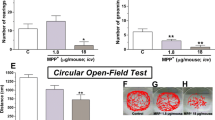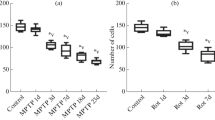Abstract
The neurotoxin MPTP can damage dopamine systems in the brains of rodents, cats, or monkeys, and is therefore widely used to model degenerative processes that underlie human Parkinson’s disease. Here, we investigated the relationships between behavioral and neurochemical effects of systemic MPTP treatment in C57BL/6 and Balb/c mice. Initially, different doses of MPTP were used to determine which of them might be useful to establish severe striatal dopamine depletions. These data showed that four injections of 20mg/kg at two hour intervals were more efficient than 10 or 15 mg/kg per injection. However, this dose was not usable due to its severe lethality in females. In contrast, 4 X 15 mg/kg had a low risk of lethality and led to substantial dopamine depletions, which were more severe in the neostriatum than the ventral striatum, and more severe in C57 than in Balb mice. In the first open field test, which was performed two hours after the last injection, this treatment led to severe behavioral inactivation in all parameters taken (distance and speed of locomotion, peripheral activity, frequency and duration of rearing). This effect was seen in both strains and gender. Thereafter, recovery differed between strains, since Balb mice, which had sustained the smaller lesions, had completely recovered on the subsequent day, whereas similar recovery took longer in C57 mice. On the fourth day, all groups appeared largely normal; however, the measure of rearing behavior still showed a deficit in C57 mice. This deficit on day 4 was correlated with neostriatal dopamine depletion; that is, the larger the lesion, the less the number and duration of rearings. Interestingly, these relationships were also observed with respect to ventral striatal dopamine damage, which was correlated with the rearing deficit not only on day 4, but also on day 1. These data will be discussed with respect to mechanisms of toxicity, functional recovery, and the function of striatal dopamine systems.
Similar content being viewed by others
References
Bradbury, A.J., Costall, B., Jenner, P.G., Kelly, M.E., Marsden, CD. and Naylor, R.J. (1986) The effect of 1-methyl-4-phenyl-1,2,3,6-tetrahydropyridine (MPTP) on striatal and limbic catecholamine neurones in white and black mice. Antagonism by monoamine oxidase inhibitors.Neuropharmacology 25, 897–904.
Chia, L.-G., Ni, D.-R., Cheng, L.-J., Kuo, J.-S., Cheng, F.-C. and Dryhurst, G. (1996) Effects of 1-methyl-4-phenyl-1,2,3,6-tetrahydropyridine and 5,7-dihydroxytryptamine on the locomotor activity and striatal amines in C57B1/6 mice.Neurosci. Lett. 218, 67–71.
Colotla, V.A., Flores, E., Oscos, A., Meneses, A. and Tapia, R. (1990) Effects of MPTP on locomotor activity in mice.Neurotoxicol. Teratol. 12, 405–407.
Donnan, G.A., Willis, G.L., Kaczmarczyk, S.J. and Rowe, P. (1987) Motor function in the 1-methyl-4-phenyl-1,2,3, 6-tetrahydropyridine-treated mouse.J. Neurol. Sci. 77, 185–191.
Elsworth, J.D., Deutch, A.Y., Redmond Jr., D.E., Taylor, J.R., Sladek Jr., J.R. and Roth, R.H. (1989) Symptomatic and asymptomatic 1-methyl-4-phenyl-1,2,3,6-tetrahydropyri-dine-treated primates: biochemical changes in striatal regions.Neuroscience 33, 323–331.
Fazzini, E., Durso, R., Davoudi, H., Szabo, G.K. and Albert, M.L. (1990) GM1 gangliosides alter acute MPTP-induced behavioral and neurochemical toxicity in mice.J. Neurol. Sci. 99, 59–68.
Fornaguera-Trias, J. and Schwarting, R.K.W. (1999) Early behavioral changes after nigro-striatal system damage can serve as predictors of striatal dopamine depletion.Prog. Neuropsychopharmacol. Biol. Psychiat. (in press).
Fornaguera, J., Schwarting, R.K.W., Boix, F. and Huston, J.P. (1993) Behavioral indices of moderate nigro-striatal 6-hydroxydopamine lesion: a preclinical Parkinson’s model.Synapse 13, 179–185.
Fornaguera, J., Carey, R.J., Huston, J.P. and Schwarting, R.K.W. (1994) Behavioral asymmetries and recovery in rats with different degrees of unilateral striatal dopamine depletion. Brain Res.664, 178–188.
Fredriksson, A. and Archer, T. (1994) MPTP-induced behavioural and biochemical deficits: a parametric analysis.J. Neural Transm. Park. Dis. Dement. Sect. 7, 123–132.
Fredriksson, A., Plaznik, A., Sundstrom, E., Jonsson, G. and Archer, T. (1990) MPTP-induced hypoactivity in mice: reversal by L-DOPA.Pharmacol. Toxicol. 67, 295–301.
Gerlach, M. and Riederer, P. (1996) Animal models of Parkinson’s disease: an empirical comparison with the phenomenology of the disease in man.J. Neural Transm. 103, 987–1041.
German, D.C., Nelson, E.L., Liang, C.L., Speciale, S.G., Sinton, CM. and Sonsalla, P.K. (1996) The neurotoxin MPTP causes degeneration of specific nucleus A8, A9 and A10 dopaminergic neurons in the mouse.Neurodegeneration 5, 299–312.
Giovanni, A., Sieber, B.A., Heikkila, R.E. and Sonsalla, P.K. (1991) Correlation between the neostriatal content of the 1-methyl-4-phenylpyridinium species and dopaminergic neurotoxicity following 1-methyl-4-phenyl-1,2,3,6-tetra-hydropyridine administration to several strains of mice.J. Pharmacol. Exp. Ther. 257, 691–697.
Hoskins, J.A. and Davis, L.J. (1989) The acute effect on levels of catecholamines and metabolites in brain, of a single dose of MPTP in 8 strains of mice.Neuropharmacology 28, 1389–1397.
Hu, S.C, Chang, F.W., Sung, Y.J., Hsu, W.M. and Lee, E.H.Y. (1991) Neurotoxic effects of 1-methyl-4-phenyl-1,2,3,6-tetra-hydropyridine in the substantia nigra and the locus coeruleus in BALB/c mice.J. Pharmacol. Exp. Ther. 259, 1379–1387.
Hung, H.C. and Lee, E.H. (1996) The mesolimbic dopaminergic pathway is more resistant than the nigrostriatal dopaminergic pathway to MPTP and MPP+ toxicity: role of BDNF gene expression.Brain Res. Mol. Brain Res. 41, 14–26.
Hung, H.C. and Lee, E.H. (1998) MPTP produces differential oxidative stress and antioxidative responses in the nigrostriatal and mesolimbic dopaminergic pathways.Free Radic. Biol. Med. 24, 76–84.
Johnston, R. and Becker, J. (1997) Intranigral grafts of fetal ventral mesencephalon tissue in adult 6-hydroxydopamine-lesioned rats can induce behavioral recovery.Cell Transplantation 6, 267–276.
Klivenyi, P., St. Clair, D., Wermer, M., Yen, H.-C., Oberley, T., Yang, L. and Beal, M.F. (1998) Manganese superoxide dis-mutase overexpression attenuates MPTP toxicity.Neurobiol. Dis. 5, 253–258.
Kupsch, M.F., Sautter, J., Schwarz, J., Riederer, P., Gerlach, M. and Oertel, W.H. (1996) 1-methyl-4-phenyl-1,2,3,6-tetrahy-dropyridine-induced neurotoxicity in non-human primates is antagonized by pretreatment with nimodipine at the nigral, but not at the striatal level.Brain Res. 741, 185–196.
Lee, E.H. and Lu, K.T. (1995) Neurotoxicity of MPTP and uptake of MPPT into dopamine and norepinephrine neurons in mice.Adv. Exp. Med. Biol. 363, 29–46.
Melega, W.P., Raleigh, M.J., Stout, D.B., DeSalles, A.A., Cherry, S.R., Blurton Jones, M., Morton, G.G., Huang, S.C. and Phelps, M.E. (1996) Longitudinal behavioral and 6-[18F]fluoro-L-DOPA-PETassessmentinMPTP-hemiparkin-sonian monkeys.Exp. Neurol. 141, 318–329.
Miklyaeva, E.I. and Whishaw, I.Q. (1996) Hemiparkinson analogue rats display active support in good limbs versus passive support in bad limbs on a skilled reaching task of variable height.Behav. Neurosci. 110, 117–125.
Mitra, N., Mohanakumar, K.P. and Ganguly, D.K. (1992) Dissociation of serotonergic and dopaminergic components in acute effects of 1-methyl-4-phenyl-1,2,3,6-tetrahydropyr-idine in mice.Brain Res. Bull. 28, 355–364.
Muthane, U., Ramsay, K.A., Jiang, H., Jackson-Lewis, V., Donaldson, D., Fernando, S., Ferreira, M. and Przedborski, S. (1994) Differences in nigral neuron number and sensitivity to 1-methyl-4-phenyl-1,2,3,6-tetrahydropyridine in C57/b1 and CD-1 mice.Exp. Neurol.,126, 195–204.
Ng, M.C., Iacopino, A.M., Quintero, E.M., Marches, E, Sonsalla, P.K., Liang, C.L., Speciale, S.G. and German, D.C. (1996) The neurotoxin MPTP increases calbindin-D28k levels in mouse midbrain dopaminergic neurons.Brain Res. Mol. Brain Res. 36, 329–336.
Nishi, K., Kondo, T. and Narabayashi, H. (1991) Destruction of norepinephrine terminals in 1-methyl-4-phenyl-1,2,3, 6-tetrahydropyridine (MPTP)-treated mice reduces locomotor activity induced by L-DOPA.Neurosci. Lett. 123, 244–247.
Ogawa, N., Hirose, Y., Ohara, S., Ono, T. and Watanabe, Y. (1985) A simple quantitative bradykinesia test in MPTP-treated mice.Res. Commun. Chem. Pathol. Pharmacol. 50, 435–441.
Przedborski, S. and Jackson-Lewis, V. (1998) Mechanisms of MPTP toxicity.Mov. Disord. 13(Suppl. 1), 35–38.
Rothblat, D.S. and Schneider, J.S. (1999) Regional differences in striatal dopamine uptake and release associated with recovery from MPTP-induced Parkinsonism: an in vivo electrochemical study.J. Neurochem. 72, 724–733.
Rozas, G., Lopez-Martin, E., Guerra, M.J. and Labandeira-Garcia, J.L. (1998) The overall rod performance test in the MPTP-treated mouse model of Parkinsonism.J. Neurosci. Meth. 83, 165–175.
Salamone, J.D. (1994) The involvement of nucleus accumbens dopamine in appetitive and aversive motivation.Behav. Brain Res. 61, 117–133.
Sanghera, M.K., Manaye, K.E, Liang, C.L., Iacopino, A.M., Bannon, M.J. and German, D.C. (1994) Low dopamine transporter mRNA levels in midbrain regions containing calbindin.Neuroreport 5, 1641–1644.
Schneider, J.S. and Rothblat, D.S. (1991) Neurochemical evaluation of the striatum in symptomatic and recovered MPTP-treated cats.Neuroscience 44, 421–429.
Schwarting, R.K.W. and Carey, R.J. (1988) Differential behavioural effects after subtotal depletions of dopamine or noradrenaline in the ventral striatum.Fund. Neurol. 3, 29–36.
Schwarting, R. and Huston, J.P. (1987) Short-term effects of ether, equithesin and droperidol/fentanyl on catecholamine and indolamine metabolism in the brain of the rat.Neuropharmacology 26, 457–461.
Schwarting, R.K. and Huston, J.P. (1996a) The unilateral 6-hydroxydopamine lesion model in behavioral brain research. Analysis of functional deficits, recovery and treatments.Prog. Neurobiol. 50, 275–331.
Schwarting, R.K. and Huston, J.P. (1996b) Unilateral 6-hydroxydopamine lesions of meso-striatal dopamine neurons and their physiological sequelae.Prog. Neurobiol. 49, 215–266.
Sershen, H., Hashim, A. and Lajtha, A. (1987) Behavioral and biochemical effects of nicotine in an MPTP-induced mouse model of Parkinson’s disease.Pharmacol. Biochem. Behav. 28, 299–303.
Sonsalla, P.K. and Heikkila, R.E. (1986) The influence of dose and dosing interval on MPTP-induced dopaminergic neurotoxicity in mice.Eur. J. Pharmacol. 129, 339–345.
Sundstrom, E., Stromberg, I., Tsutsumi, T, Olson, L. and Jonsson, G. (1987) Studies on the effect of 1-methyl-4-phenyl-1,2,3,6-tetrahydropyridine (MPTP) on central catecholamine neurons in C57BL/6 mice. Comparison with three other strains of mice.Brain Res. 405, 26–38.
Sundstrom, S., Frederiksson, A. and Archer, T. (1990) Chronic neurochemical and behavioral changes in MPTP-lesioned C57BL/6 mice: a model for Parkinson’s disease.Brain Res. 528, 181–188.
Tadano, T, Satoh, N., Sakuma, I., Matsumura, T, Kisara, K., Arai, Y. and Kinemuchi, H. (1987) Behavioral and biochemical changes following acute administration of MPTP and MPP+.Life Sci. 40, 1309–1318.
Unzeta, M., Baron, S., Perez, V., Ambrosio, S. and Mahy, N. (1994) Sex-related effects of 1-methyl-4-phenyl-1,2,3,6-tetra-hydro-pyridine treatment may be related to differences in monoamine oxidase B.Neurosci. Lett. 176, 235–238.
Weihmuller, F.B., Hadjiconstantinou, M. and Bruno, J.P. (1988) Acute stress or neuroleptics elicit sensorimotor deficits in MPTP-treated mice.Neurosci. Lett. 85, 137–142.
Weihmuller, F.B., Hadjiconstantinou, M. and Bruno, J.P. (1990) Dopamine receptors and sensorimotor behavior in MPTP-treated mice.Behav. Brain Res. 38, 263–273.
Willis, G.L. and Donnan, G.A. (1987) Histochemical, biochemical and behavioural consequences of MPTP treatment in C-57 black mice.Brain Res. 402, 269–274.
Yurek, D.M., Deutch, A.Y., Roth, R.H. and Sladek Jr., J.R. (1989) Morphological, neurochemical, and behavioral characterizations associated with the combined treatment of diethyldithiocarbamate and 1-methyl-4-pheny 1-1,2,3,6-tetrahydropyridine in mice.Brain Res. 497, 250–259.
Zigmond, M.J., Abercrombie, E.D., Berger, T.W., Grace, A.A. and Strieker, E.M. (1990) Compensation after lesions of central dopaminergic neurons: some clinical and basic implications.Trends Neurosci. 13, 290–296.
Author information
Authors and Affiliations
Rights and permissions
About this article
Cite this article
Schwarting, R.K.W., Sedelis, M., Hofele, K. et al. Strain-dependent recovery of open-field behavior and striatal dopamine deficiency in the mouse MPTP model of Parkinson’s disease. neurotox res 1, 41–56 (1999). https://doi.org/10.1007/BF03033338
Received:
Revised:
Issue Date:
DOI: https://doi.org/10.1007/BF03033338




